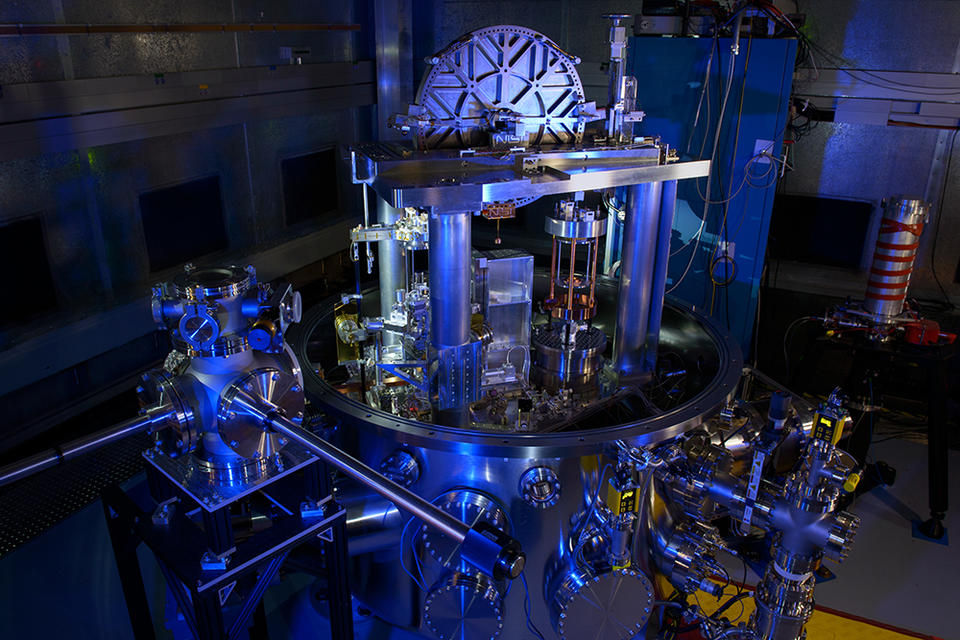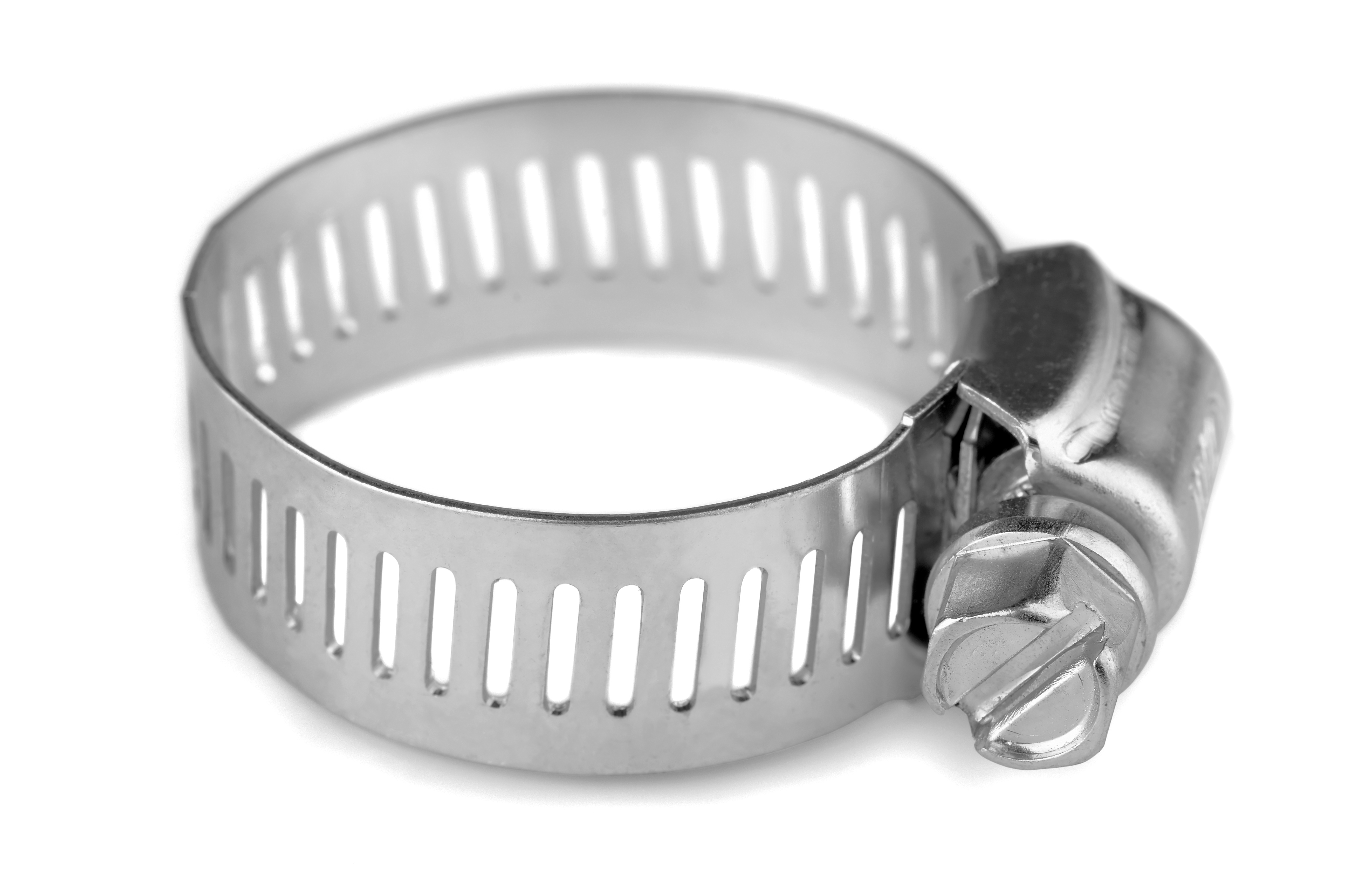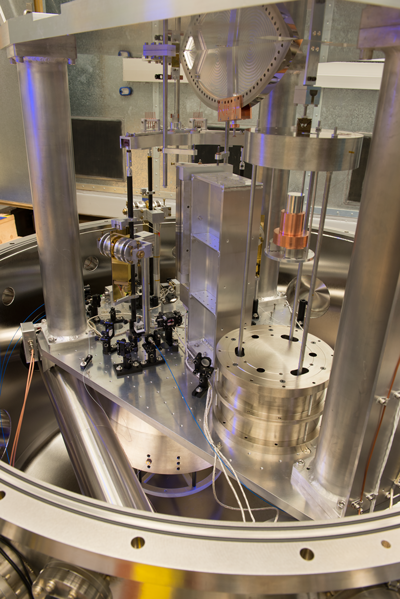Taking Measure
Just a Standard Blog

Even without the dramatic lighting, the NIST-4 Kibble balance that our team used to help redefine the kilogram is what I call a beautiful instrument!
I discovered my affinity for attractive instruments while working a job previous to my coming to NIST. My boss then had a love affair with the common hose clamp—the one with the worm gear. Whenever we had to fasten a component to an apparatus he said, “why don’t you use a hose clamp?” With every hose clamp that we added to the experiment, my hatred for them grew larger, and I started to develop the philosophy of the “beautiful instrument.” While back then, any hose-clamp-free instrument qualified as one, I have refined my threshold since. The biggest kudos I could give the students working for my boss and me was the statement, “This is what I call a beautiful instrument.” In my ideal world, all researchers would aim to build an instrument (or experiment or apparatus) with aesthetic appeal.
All other things being equal, if you had the choice between working with a good-looking instrument or an ugly one, which would you choose? Of course, you would choose the beautiful instrument because it is joyful to be surrounded by lovely things. Following this logic, no ugly experiment should exist in the world and we can close the case. Wait, not so fast! As a matter of fact, there are ugly instruments (maybe not at NIST, though). So, we need to discuss how ugly instruments come into being.
Well, it all starts with the hose clamp.

No instrument is designed to be ugly. All instruments are trying to measure a fundamental property of our universe or an object/material therein and as such are conceived as an elegant idea. A design is made to tackle the measurement problem and a first iteration of the instrument is built. So far everything looks good, but ugliness soon starts to creep in. You put the first iteration to the test and, as always is the case with first iterations, things don’t work as intended. Bolt patterns don’t match up. Clearances become interferences, and it becomes apparent that you did not even think about cable management.
But you have the first prototype in your hand, fresh from the machine shop, and you are eager to make a measurement. So, by hook or by crook, you make it work. You break out the duct tape, the zip ties, the hose clamps, the hacksaw, the file and the cordless drill to modify the instrument to get the job done. Ten years later the instrument still works and is still in your lab with the duct tape, zip ties, and hose clamps that you put on during the first week of the experiment. This is the way ugly instruments are born and continue to exist for a long time. Yes, you got your mission accomplished, but you also deprived yourself of nine joyful years because you had to be around that zip-tie and hose clamp-laden monstrosity.
What if I told you that, in the scenario discussed above, there was a way to accomplish the mission, with maybe a slight delay, but also have a lot more joy, satisfaction and fun working because you are interacting with a thing of beauty. And, even better, it will outperform the ugly one because it is easier to spot if something is misaligned. Have you ever noticed how easily you notice an exquisite thing’s smallest fault? If your experiment is out of alignment, it is much easier to see in an attractively organized setup than in a morass of temporary kludges. So, in the long run, a beautiful instrument may even save you time because you don’t waste days taking data with a misaligned instrument only to find out after the fact.
I am not advocating forgoing success with the first prototype that you get going with zip ties, hose clamps and duct tape. I think this is an important phase in the scientific endeavor. You should be proud of your achievement: You made the first measurement and you have a proof of principle of the apparatus. But then, pause. Look at your instrument and design iteration two. Improve all the flaws that you have identified and spend some time to make the instrument beautiful. In the end, the instrument is going to be around for a long time, so the little extra time and cost that you spend at the beginning is not significant, especially if the lovely iteration outperforms the patched-up one.
The more obvious benefit of an alluring instrument is that it makes for an eye-catching photo that can give you exposure. While you may be able to impress the subject matter expert with a picture of an ugly experiment because she can peel the onion of ugliness and get to the measurement principle, you will not score points with the public. They will say, “Yeah, looks like science.” But this pales in comparison to the statement that you can get from a picture of your gorgeous instrument, “Wow, science is so breathtaking!” And, believe me, you want the latter.

Experiments become ugly in the tense space between obtaining a fast solution and doing the right thing, the beautiful solution. Once a fast solution is found, the pressing need to tend to the problem evaporates, and the beautiful solution is never revisited. Hence, if a quick solution was chosen, it often stays in place for a long time. In the decision-making process, ugliness is not the antagonist of beauty. Instead, the real enemy of beauty is expediency. Nobody likes to choose an ugly solution. But people like to choose the expedient solution. The phrase “quick and dirty” captures the mechanism precisely.
The crux is, how does one weigh disparate categories like beauty and convenience against each other? Clearly, the parameter range in each category is more than black and white. There are as infinitely many shades of grey between ugly and beautiful as there are between fast and slow. So, where do you draw the line if you have to make a decision? It’s difficult to give general guidance on how to decide between an expedient and an elegant solution. I would say, if in doubt, err on the more appealing, but slower side, because in the long run, it is better to live with a fine-looking solution than one that was found quickly. In a few years, no one will remember if the solution was expedient, but everyone is still impressed by the attractiveness of the instrument. Another way of saying this is: Expedience fades, but beauty remains.
While I believe it is best to have more splendor at the cost of simplicity, if you can find a way to have both, by all means, go for it. But don’t be deceived by the air of ease, grace and lightness that surrounds this combination. Any instrument that is so refined is the result of hard work. I believe the attractiveness of objects that are practical and beautiful is a direct consequence of the fact that they let us forget the blood, sweat and tears it took to conceive and make them. On the other hand, an ugly instrument will always remind us of the struggle required to construct it.
In summary, when it comes to building instruments, the gold standard is simple and beautiful. If you have to make a compromise, choose beauty. Now, go and make the world a better place: Build more beautiful instruments!
About the author
Related Posts
Comments
Dear Jesse,
Thank you very much for your encouraging comment. I agree with the points that you make.
There is a problem here. 'Beauty is in the eye of the beholder'. Maybe you mean that an instrument should be simple and functional. The hose clamp looks quite attractive to me! Lovely article anyway.
Dear Malcolm,
You're absolutely right that beauty is subjective and not objectively measurable. I also agree that the instrument has to be functional for sure. But, I'd argue that the instrument maker should build it beautiful to his/her own standard.
For publicly funded projects and agencies, there is beauty in efficient use of resources. If the versatile hose clamp is adequate to the task, spending time and money custom milling a pretty component and media campaign does not look beautiful to many citizens.
Dear Eric,
I agree with you. There is beauty in using resources (time & funding) efficiently. And, in public service, we should all strive to achieve this kind of beauty. I am not advocating elegance at all expense. Very often, good looks can be obtained at a small price. Take cable management as an example, with very cheap zip ties, a rat’s nest of wires can be organized in an orderly wire harness. With the post, I am trying to motivate people to think twice, before they are doing a hack job. As mentioned in the post, beauty can, in the long run, save money.
Any well designed tool is beautiful. The curves of an efficient boat hull are sensuous and lovely...even if one does not understand hydrodynamics. Even a well balanced hammer can have a bit of artistry about it.
Lovely article, thank you. The same can be said about theoretical solutions, some of which are more elegant than others. And by the way, that was a beautiful picture of a hose clamp. It may be put to ugly use, but the humble hose clamp by itself is a versatile, simple, effective, and - let us say it - beautiful tool.
Your article was a good read, and even though I'm a boomer, I can relate and appreciate what you've said.
I'm a citizen scientist involved in physics, astro, geo, classical, GR, & QM. With a focus on Magnetic field physics. The device I'm producing now Is a 4th iteration, of something I discovered back in 2018 the ugly experiment. It's an educational device for high schools, colleges, & universities. Think of CERN, Penning traps, and magnetic bottles. This iteration will be beautiful!! But beautiful demo are not cheap!!
I always look forward to seeing the emails from NIST. Wish I could've work for NIST rather than being an accounting controller for general engineering contractors.
Thanks for everything you guys do there and all you have taught me!!!
Wonderful article!
Your two statements, "Once a fast solution is found, the pressing need to tend to the problem evaporates, and the beautiful solution is never revisited." and "if in doubt, err on the more appealing, but slower side, because in the long run, it is better to live with a fine-looking solution than one that was found quickly." also apply to software, and the concept there is "technical debt." The debt is always a burden, and can lead someone into a sunk cost fallacy, preventing another iteration toward elegance.






This was a great read! Thank you.
Aesthetically pleasing tools and machines also last longer and their users often maintain a higher standard in their work. Just using a beautiful tool changes the way people think about their work.
Obviously, things have to function and that can’t be compromised, but there’s no good reason functional and beautiful have to be separate.